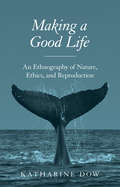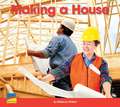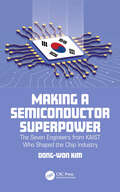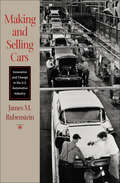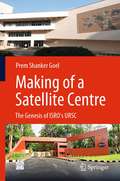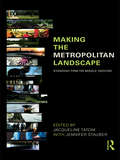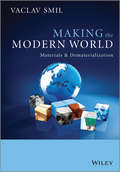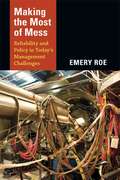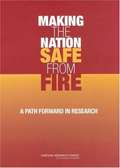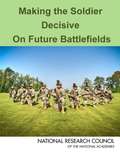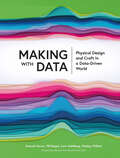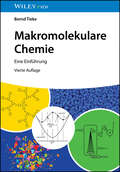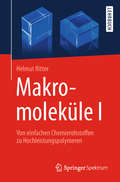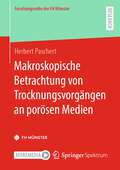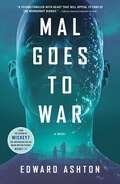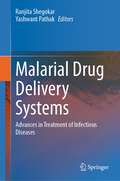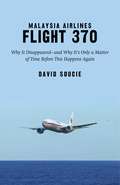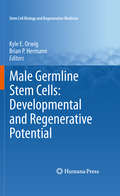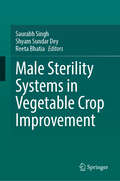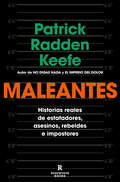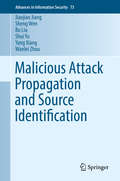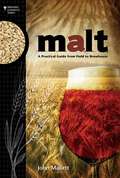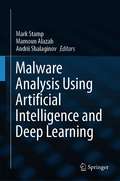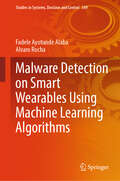- Table View
- List View
Making a Good Life: An Ethnography of Nature, Ethics, and Reproduction
by Katharine DowMaking a Good Life takes a timely look at the ideas and values that inform how people think about reproduction and assisted reproductive technologies. In an era of heightened scrutiny about parenting and reproduction, fears about environmental degradation, and the rise of the biotechnology industry, Katharine Dow delves into the reproductive ethics of those who do not have a personal stake in assisted reproductive technologies, but who are building lives inspired and influenced by environmentalism and concerns about the natural world's future.Moving away from experiences of infertility treatments tied to the clinic and laboratory, Dow instead explores reproduction and assisted reproductive technologies as topics of public concern and debate, and she examines how people living in a coastal village in rural Scotland make ethical decisions and judgments about these matters. In particular, Dow engages with people's ideas about nature and naturalness, and how these relate to views about parenting and building stable environments for future generations. Taking into account the ways daily responsibilities and commitments are balanced with moral values, Dow suggests there is still much to uncover about reproductive ethics. Analyzing how ideas about reproduction intersect with wider ethical struggles, Making a Good Life offers a new approach to researching, thinking, and writing about nature, ethics, and reproduction.
Making a House
by Rebecca WeberThis book is about the types and purposes of tools that are used to build houses.
Making a Semiconductor Superpower: The Seven Engineers from KAIST Who Shaped the Chip Industry
by Dong-Won KimThis book provides real stories about the South Korean semiconductor community. It explores the lives and careers of six influential semiconductor engineers who all studied at Korea Advanced Institute of Science and Technology (KAIST) under the mentorship of Dr. Kim Choong-Ki, the most influential semiconductor professor in South Korea during the last quarter of the twentieth century. Kim’s students became known as “Kim’s Mafia” because of the important positions they went on to hold in industry, government, and academia. This book will be of interest to semiconductor engineers and electronics engineers, historians of science and technology, and scholars and students of East Asian studies. “They were called ‘Kim’s Mafia.’ Kim Choong-Ki himself wouldn’t have put it that way. But it was true what semiconductor engineers in South Korea whispered about his former students: They were everywhere. … Kim was the first professor in South Korea to systematically teach semiconductor engineering. From 1975, when the nation had barely begun producing its first transistors, to 2008, when he retired from teaching, Kim trained more than 100 students, effectively creating the first two generations of South Korean semiconductor experts.” (Source: IEEE Spectrum, October, 2022.)
Making and Selling Cars: Innovation and Change in the U.S. Automotive Industry
by James M. RubensteinFrom the creation of fast food, to the design of cities, to the character of our landscape, the automobile has shaped nearly every aspect of modern American life. In fact, the U.S. motor vehicle industry is the largest manufacturing industry in the world.James Rubenstein documents the story of the automotive industry... which despite its power, is an industry constantly struggling to redefine itself and assure its success. Making and Selling Cars: Innovation and Change in the U.S. Automotive Industry shows how this industry made adjustments and fostered innovations in both production and marketing in order to remain a viable force throughout the twentieth-century.Rubenstein builds his study of the American auto industry with care, taking the reader through this quintessentially modern history of production and consumption. Avoiding jargon while never over simplifying, Rubenstein gives a detailed and straightforward account of both the production and merchandising of cars. We learn how the industry began and about its methods for building cars and the modern American marketplace. Along the way there were many missteps and challenges—the Edsel, the fuel crisis, and the ascendancy of Japanese cars in the 1980s. The industry met these types of problems with new techniques and approaches. To demonstrate this, Rubenstein gives the reader examples of how the auto industry used to work, which he alternates with chapters showing how the industry has reinvented itself. Making and Selling Cars explains why the U.S. automotive industry has been and remains a vigorous shaper of the American economy.
Making of a Satellite Centre: The Genesis of ISRO's URSC
by Prem Shanker GoelThis book tells the story of the evolution of the Satellite Center which started from a small Satellite Systems Division in 1967 with a handful of engineers to a vibrant R&D center which is playing the lead role in the Indian Satellite Program. India's space program is unique as it is driven by societal applications. The Indian Space Research Organisation (ISRO) has centers dedicated to various space applications. The ISRO Satellite Centre, now known as the UR Rao Satellite Centre (URSC), has evolved as lead center for Satellite Technology over five decades and has developed state-of-the-art satellites for applications such as remote sensing, satellite communication and space science. Through the story of URSC, the book describes the challenges of putting together new research and development centers and programs and conveys the importance of leadership and project management skills required to undertake such a task. This book is of interest to researchers, professionals, and administrators involved in the development of new R&D facilities and also to space scientists and space enthusiasts across the world.
Making the Metropolitan Landscape: Standing Firm on Middle Ground
by Jacqueline Tatom Jennifer StauberThe American landscape is an extremely complex terrain born from a history of collective and individual experiences. These created environments, which all may be called metropolitan landscapes, constantly challenge students and professionals in the fields of architecture, design and planning to consider new ways of making lively public places. This book brings together varied voices in urban design theory and practice to explore new ways of understanding place and our position in it.
Making the Modern World
by Vaclav SmilHow much further should the affluent world push its material consumption? Does relative dematerialization lead to absolute decline in demand for materials? These and many other questions are discussed and answered in Making the Modern World: Materials and Dematerialization.Over the course of time, the modern world has become dependent on unprecedented flows of materials. Now even the most efficient production processes and the highest practical rates of recycling may not be enough to result in dematerialization rates that would be high enough to negate the rising demand for materials generated by continuing population growth and rising standards of living. This book explores the costs of this dependence and the potential for substantial dematerialization of modern economies. Making the Modern World: Materials and Dematerialization considers the principal materials used throughout history, from wood and stone, through to metals, alloys, plastics and silicon, describing their extraction and production as well as their dominant applications. The evolving productivities of material extraction, processing, synthesis, finishing and distribution, and the energy costs and environmental impact of rising material consumption are examined in detail. The book concludes with an outlook for the future, discussing the prospects for dematerialization and potential constrains on materials.This interdisciplinary text provides useful perspectives for readers with backgrounds including resource economics, environmental studies, energy analysis, mineral geology, industrial organization, manufacturing and material science.
Making the Most of Mess: Reliability and Policy in Today's Management Challenges
by Emery RoeIn Making the Most of Mess, Emery Roe emphasizes that policy messes cannot be avoided or cleaned up; they need to be managed. He shows how policymakers and other professionals can learn these necessary skills from control operators who manage large critical infrastructures such as water supplies, telecommunications systems, and electricity grids. The ways in which they prevent major accidents and failures offer models for policymakers and other professionals to manage the messes they face. Throughout, Roe focuses on the global financial mess of 2008 and its ongoing aftermath, showing how mismanagement has allowed it to morph into other national and international messes. More effective management is still possible for this and many other policy messes but that requires better recognition of patterns and formulation of scenarios, as well as the ability to translate pattern and scenario into reliability. Developing networks of professionals who respond to messes is particularly important. Roe describes how these networks enable the avoidance of bad or worse messes, take advantage of opportunities resulting from messes, and address societal and professional challenges. In addition to finance, he draws from a wide range of case material in other policy arenas. Roe demonstrates that knowing how to manage policy messes is the best approach to preventing crises.
Making the Nation Safe from Fire: A Path Forward in Research
by Committee to Identify Innovative Research Needs to Foster Improved Fire Safety in the United StatesInformation on Making the Nation Safe from Fire
Making the Soldier Decisive on Future Battlefields
by Division On Engineering Physical SciencesThe U. S. military does not believe its soldiers, sailors, airmen, and marines should be engaged in combat with adversaries on a "level playing field. " Our combat individuals enter engagements to win. To that end, the United States has used its technical prowess and industrial capability to develop decisive weapons that overmatch those of potential enemies. In its current engagement--what has been identified as an "era of persistent conflict"-- the nation's most important weapon is the dismounted soldier operating in small units. Today's soldier must be prepared to contend with both regular and irregular adversaries. Results in Iraq and Afghanistan show that, while the U. S. soldier is a formidable fighter, the contemporary suite of equipment and support does not afford the same high degree of overmatch capability exhibited by large weapons platforms--yet it is the soldier who ultimately will play the decisive role in restoring stability. Making the Soldier Decisive on Future Battlefields establishes the technical requirements for overmatch capability for dismounted soldiers operating individually or in small units. It prescribes technological and organizational capabilities needed to make the dismounted soldier a decisive weapon in a changing, uncertain, and complex future environment and provides the Army with 15 recommendations on how to focus its efforts to enable the soldier and tactical small unit (TSU) to achieve overmatch.
Making with Data: Physical Design and Craft in a Data-Driven World (AK Peters Visualization Series)
by Samuel Huron Till Nagel Lora Oehlberg Wesley WillettHow can we give data physical form? And how might those creations change the ways we experience data and the stories it can tell? Making with Data: Physical Design and Craft in a Data-Driven World provides a snapshot of the diverse practices contemporary creators are using to produce objects, spaces, and experiences imbued with data. Across 25+ beautifully-illustrated chapters, international artists, designers, and scientists each explain the process of creating a specific data-driven piece—illustrating their practice with candid sketches, photos, and design artifacts from their own studios. Featuring influential voices in computer science, data science, graphic design, art, craft, and architecture, Making with Data is accessible and inspiring for enthusiasts and experts alike.
Makromolekulare Chemie: Eine Einführung
by Bernd TiekeSeit mehr als 25 Jahren ist dieses Lehrbuch das Standardwerk zum Einstieg in die Makromolekulare Chemie. Kompakt, übersichtlich und verständlich werden die Synthese, Charakterisierung, Eigenschaften und Reaktionen sowie Anwendungen von Polymeren beschrieben. Für die vierte Auflage wurde das Buch komplett überarbeitet, aktualisiert und um wichtige Kapitel erweitert, wie z.B. natürliche Polymere und Biomakromoleküle, Dendrimere, hyperverzweigte Polymere und Sternpolymere, Synthesemöglichkeiten mittels Click-Chemie, Additive für Polymere, selbstheilende Polymere, Elektrospinnen, 3D-Druck von Polymeren und Mikroplastik. Durch die Änderungen sind der Materialaspekt und die technische Seite der Makromolekularen Chemie stärker betont worden. Neben einer Zusammenfassung der wichtigsten Inhalte am Ende jedes Kapitels sind erstmals auch Fragen und Antworten enthalten, die es ermöglichen, das erworbene Wissen selbstständig zu überprüfen und sich erfolgreich auf Prüfungen vorzubereiten. Mit seinem bewährten Konzept ist das Buch der ideale Begleiter für alle Studierenden der Chemie im Haupt- und Nebenfach sowie der Materialwissenschaften. Für Chemiker und Ingenieure, die sich in das Thema schnell einlesen wollen, sei dieses Buch ebenfalls wärmstens empfohlen!
Makromoleküle I: Von einfachen Chemierohstoffen zu Hochleistungspolymeren
by Helmut RitterEin praxisorientiertes Lehrbuch zum nachhaltigen Verständnis über Herstellung und Eigenschaften von Kunststoffen. Auch ökonomische und Umwelt-Aspekte werden umrissen. Das Buch richtet sich an Studierende der Chemie sowie an Forscher in Industrie und Instituten.
Makroskopische Betrachtung von Trocknungsvorgängen an porösen Medien (Forschungsreihe der FH Münster)
by Herbert PaschertIn diesem Buch werden zwei Berechnungsverfahren zur Berechnung von Trocknungsvorgängen an halbunendlichen längsüberströmten symmetrischen Platten beschrieben. Die Methoden unterscheiden sich in Bezug auf den Wassergehalt an der Oberfläche der Platte. Das erste Modell „vollständig benetzte Oberfläche“ nimmt eine mit Wasserdampf gesättigte Luftschicht oberhalb der Flüssigkeitsschicht auf der Platte an. Daraus resultiert eine Oberfläche mit Kühlgrenztemperatur und einer konstanten Trocknungsgeschwindigkeit. Es wird von Verdunstungstrocknung gesprochen, da die Siedetemperatur nicht erreicht wird und sich der Partialdruck des Dampfes in der Luft erhöht, die Luft wird feuchter. Das zweite Modell „sinkender Trocknungsspiegel“ beschreibt die Aufheizung der Gipskartonplatte in verschiedenen Schichten. Erreicht die wasserhaltige Schicht die Siedetemperatur, so verdampft das flüssige Wasser. Der Wasserverlust lässt einen fiktiven Trocknungsspiegel im Gips absinken und ändert somit die Verhältnisse der Wärmeübergänge der Karton-, trockenen und feuchten Gipsschicht, somit sinkt die Trocknungsrate über die Zeit ab. Es wird von Verdampfungstrocknung gesprochen, da der eingehende Wärmestrom die Wassermasse bei Siedetemperatur verdampft.
Mal Goes to War: A Novel
by Edward AshtonThe humans are fighting again. Go figure.As a free A.I., Mal finds the war between the modded and augmented Federals and the puritanical Humanists about as interesting as a battle between rival anthills. He’s not above scouting the battlefield for salvage, though, and when the Humanists abruptly cut off access to infospace he finds himself trapped in the body of a cyborg mercenary, and responsible for the safety of the modded girl she died protecting.A dark comedy wrapped in a techno thriller’s skin, Mal Goes to War provides a satirical take on war, artificial intelligence, and what it really means to be human.
Malarial Drug Delivery Systems: Advances in Treatment of Infectious Diseases
by Yashwant Pathak Ranjita ShegokarThis book targets new advances in areas of treatment and drug delivery sciences for Malaria. This is the only published book which compiles the complete road map of malarial drug delivery systems along with an overview on the pathology, current state of malaria across the globe, new clinical trials, emerging drugs and evolving novel drug delivery platforms. A wide variety of novel micro-and nano-formulations using promising technologies are being explored to deliver the malarial drug via different administration routes. This book addresses the gap between new approaches and old treatment modalities and how the former is superior in pharmacological performance when tested in in-vitro and in-vivo. Audience from wide range group like from researchers to regulatory bodies can benefit from the compiled information to find out patient needs and addresses a much-needed update to the existing malaria drug delivery research.
Malaysia Airlines Flight 370: Why It Disappeared?and Why It?s Only a Matter of Time Before This Happens Again
by David SoucieOn March 8, 2014, Malaysia Airlines Flight 370 loaded 239 people on board and took off for what should have been a six-hour flight. It never made it--and it’s still missing. It’s been a year since Malaysia Airlines Flight 370 vanished, and there’s still no sign of the aircraft, its passengers, or its crew--nor confirmation of what happened or where the aircraft resides. In this gripping investigation of the events that led to the plane’s disappearance--and why they could happen again--CNN aviation analyst David Soucie exposes the flaws in the aviation industry, shares what needs to be done so a plane doesn’t go missing again, and uses a Bayesian analysis model to reveal what most likely happened on board the plane that led to its downfall. Comprehensive in scope, personal and empathetic in voice, Soucie draws on his thirty years of experience as an accident investigator working with the Federal Aviation Administration. He allows you to put the wild speculation about the plane’s disappearance aside and assess the facts through the eyes of an experienced accident investigator.
Male Germline Stem Cells: Developmental and Regenerative Potential
by Brian P. Hermann Kyle E. OrwigScientists investigating germ cells have, over the past 15 years, originated discoveries and innovations that give us valuable insights into the mechanisms that regulate not just stem cell function, but human development in its widest sense. With contributions from some of the leading researchers in the field, Male Germline Stem Cells: Developmental and Regenerative Potential assesses the implications of these discoveries for understanding the fundamental biology of germline stem cells as well as their potential for human stem cell-based therapies. This monograph covers many of the fundamental issues now being explored by today's generation of stem cell researchers, including the field's potential for regenerative medicine. Ranging from an assessment of the pluripotency of primordial germ cells and their possible applications in treating testicular cancer, to the recovery of once-mordant fertilization-competent sperm, this volume has it all. It is a reference point for any scientist involved in related research as well as being a timely summation of what could prove to be a hugely exciting and very fruitful area of inquiry.
Male Sterility Systems in Vegetable Crop Improvement
by Saurabh Singh Shyam Sundar Dey Reeta BhatiaThis book covers different male sterility systems employed for genetic improvement of vegetable crops. Various aspects such as cytoplasmic male sterility (CMS), genic male sterility (GMS) and cytoplasmic genic male sterility (CGMS), and their exploitation in hybrid breeding of vegetable crops is also discussed. This book provides the timeline of key breakthroughs made in the male sterility systems and their exploitation in vegetable crop improvement. The information compiled is of great relevance to current need of global food security. Precise genome editing through CRISPR/Cas9 and other advanced techniques has made it possible to engineer male sterility in vegetable crops. Due to the pressing issue of climate change, the diversification of cytoplasm is important and hence, the role of alien cytoplasm in developing novel male sterility systems in vegetable crops is also explored. This book is resourceful for the researchers, students, scientists, teachers and private players interested in hybrid vegetable seed industry.
Maleantes: Historias reales de estafadores, asesinos, rebeldes e impostores
by Patrick Radden KeefeTras No digas nada y El imperio del dolor, Patrick Radden Keefe explora los límites, a menudo imperceptibles, entre lo legal y lo ilegal, a través de doce retratos reales protagonizados por maleantes de medio mundo LIBRO DE LA SEMANA POR EL PERIÓDICO «Keefe hahecho carrera sumergiéndose en personajes fascinantes, en eso es el mejor. [...] En Maleantes regresa con su altísimo rigor periodístico y la misma pasión de siempre por desvelar misterios, con un resultado inconfundible».New York Times Book Review «Un narrador virtuoso».The Washington PostCon el fascinante estilo que le caracteriza, Patrick Radden Keefe ofrece en este libro una compleja panorámica del lado oscuro del ser humano. Aquí retrata, entre otros personajes, al traficante de armas Monzer al-Kassar, apodado «el príncipe de Marbella» y perseguido incansablemente por un agente de la D.E.A., a la controvertida «abogada del diablo» que lucha contra la pena de muerte representando a los peores criminales, al Chapo Guzmán y su vida tras huir de una prisión de alta seguridad, o al célebre delincuente holandés William Holleeder y los esfuerzos de su propia hermana para lograr su encarcelación. Maleantes recoge doce perfiles de estafadores, truhanes, asesinos y rebeldes, gente que nada a contracorriente y cuya vida excepcional, para bien y para mal, invita al lector a reflexionar sobre temas como la esencia del mal, del poder, del crimen y de la corrupción, pero también sobre el coraje de quienes decidieron enfrentarse a ellos. La crítica ha dicho... «Una obra rigurosa y literaria. [...] Honesto y escrupuloso, [Radden Keefe] es la cara y la cruz del periodismo».Marta Ailouti, El Cultural «Lo ha vuelto a hacer. Una no-ficción que se lee como un thriller y se sigue como la trama de una película. [...] La recomiendo mucho».Glòria Aznar, Diari de Tarragona «El catálogo de personajes que desfilan por aquí es digno del Hollywood más oscuro: crímenes, sí, pero también con glamur y carisma».Adrià Puértolas, El Nacional «El periodista narrativo más prestigioso de su generación».Gonzalo Suárez, El Mundo«Un conjunto de relatos con afán literario, como la antología de cuentos de un escritor con voluntad de estilo; solo que aquí prima la verdad, y los hechos de los relatos se ciñen a un concienzudo fact checking».José S. de Montfort, The Objective«La magnífica prosa de investigación de Keefe tiene elementos propios de la crónica literaria y podría recordar un poco a Gay Talese en el sentido de ser un periodista de raza que guarda el deseo de llegar al fondo de la cuestión en lo que tenga entre manos y una gran vocación de observador».Toni Montesinos, La Razón «Con su envidiable manera de mirar y contar, dibuja retratos depersonajes tan paródicos como crueles, estúpidos e insanos, tiernos y horribles. Talento y rigor».Carlos Zanón, La Vanguardia «Un nuevo libro de Keefe significa dejarlo todo y bajar las persianas; estarás pasando páginas durante horas».Los Angeles Times«Maleantes no es solo la muestra de lo buen periodista que es su autor, sino del inmenso poder del reportaje como género. Quizá el mayor don que tiene Keefe como escritor es la comodidad con la que se mueve en terrenos ambiguos, un recordatorio oportuno de que las cosas no son nunca blancas o negras».Toronto Star «Un espectacular libro de periodismo en mayúsculas».Irish Independent
Malicious Attack Propagation and Source Identification (Advances in Information Security #73)
by Bo Liu Yang Xiang Shui Yu Wanlei Zhou Sheng Wen Jiaojiao JiangThis book covers and makes four major contributions: 1) analyzing and surveying the pros and cons of current approaches for identifying rumor sources on complex networks; 2) proposing a novel approach to identify rumor sources in time-varying networks; 3) developing a fast approach to identify multiple rumor sources; 4) proposing a community-based method to overcome the scalability issue in this research area. These contributions enable rumor source identification to be applied effectively in real-world networks, and eventually diminish rumor damages, which the authors rigorously illustrate in this book. In the modern world, the ubiquity of networks has made us vulnerable to various risks. For instance, viruses propagate throughout the Internet and infect millions of computers. Misinformation spreads incredibly fast in online social networks, such as Facebook and Twitter. Infectious diseases, such as SARS, H1N1 or Ebola, have spread geographically and killed hundreds of thousands people. In essence, all of these situations can be modeled as a rumor spreading through a network, where the goal is to find the source of the rumor so as to control and prevent network risks. So far, extensive work has been done to develop new approaches to effectively identify rumor sources. However, current approaches still suffer from critical weaknesses. The most serious one is the complex spatiotemporal diffusion process of rumors in time-varying networks, which is the bottleneck of current approaches. The second problem lies in the expensively computational complexity of identifying multiple rumor sources. The third important issue is the huge scale of the underlying networks, which makes it difficult to develop efficient strategies to quickly and accurately identify rumor sources. These weaknesses prevent rumor source identification from being applied in a broader range of real-world applications. This book aims to analyze and address these issues to make rumor source identification more effective and applicable in the real world. The authors propose a novel reverse dissemination strategy to narrow down the scale of suspicious sources, which dramatically promotes the efficiency of their method. The authors then develop a Maximum-likelihood estimator, which can pin point the true source from the suspects with high accuracy. For the scalability issue in rumor source identification, the authors explore sensor techniques and develop a community structure based method. Then the authors take the advantage of the linear correlation between rumor spreading time and infection distance, and develop a fast method to locate the rumor diffusion source. Theoretical analysis proves the efficiency of the proposed method, and the experiment results verify the significant advantages of the proposed method in large-scale networks. This book targets graduate and post-graduate students studying computer science and networking. Researchers and professionals working in network security, propagation models and other related topics, will also be interested in this book.
Malt: A Practical Guide from Field to Brewhouse (Brewing Elements)
by John MallettOften playing second fiddle to hops in the minds of craft beer drinkers, malt is the backbone of beer: &“No barley, no beer.&” Malt defines the color, flavor, body, and alcohol of beer and has been cultivated for nearly as long as agriculture has existed. In this book, author John Mallett explains why he feels a book on malt is necessary, taking the reader on a brief history of malting from the earliest records of bappir through to the Middle Ages and Early Modern Period. When Mallett touches on the major changes wrought by the Industrial Revolution and beyond, he illustrates how developments in malting technology were intertwined with politics and taxation, which increasingly came to bear on the world of maltsters and brewers.Of course, no book on malt would be complete without a look at the processes behind malting and how different malts are made. Mallett neatly conveys the basics of malt chemistry, Maillard reactions, and diastatic power—the enzymes, starches, sugars, glucans, phenols, proteins, and lipids involved. Descriptions of the main types of malt are included, from base malt, caramel malts, and roasted malts through to specialty malts and other grains like wheat, rye, and oats. Information is interspersed with the thoughts and wisdom of some of America's most respected craft brewers.Understanding an ingredient requires appreciating where it comes from and how it is grown. The author condenses the complexities of barley anatomy and agriculture into easy, readable sections, seamlessly combining these details with high-level look at the economic and environmental pressures that dictate the livelihoods of farmers and maltsters. Mallett explains how to interpret—and when to rely on—malt quality and analysis sheets, an essential skill for brewers. There is a summary of the main barley varieties, both modern and heritage, from Europe and America. The book finishes with what happens to the malt once it reaches the brewery, addressing issues of malt packaging, handling, preparation, storage, conveyance, and milling in the brewhouse.
Malware Analysis Using Artificial Intelligence and Deep Learning
by Mark Stamp Mamoun Alazab Andrii ShalaginovThis book is focused on the use of deep learning (DL) and artificial intelligence (AI) as tools to advance the fields of malware detection and analysis. The individual chapters of the book deal with a wide variety of state-of-the-art AI and DL techniques, which are applied to a number of challenging malware-related problems. DL and AI based approaches to malware detection and analysis are largely data driven and hence minimal expert domain knowledge of malware is needed.This book fills a gap between the emerging fields of DL/AI and malware analysis. It covers a broad range of modern and practical DL and AI techniques, including frameworks and development tools enabling the audience to innovate with cutting-edge research advancements in a multitude of malware (and closely related) use cases.
Malware Detection on Smart Wearables Using Machine Learning Algorithms (Studies in Systems, Decision and Control #549)
by Alvaro Rocha Fadele Ayotunde AlabaThis book digs into the important confluence of cybersecurity and big data, providing insights into the ever-changing environment of cyber threats and solutions to protect these enormous databases. In the modern digital era, large amounts of data have evolved into the vital organs of businesses, providing the impetus for decision-making, creativity, and a competitive edge. Cyberattacks pose a persistent danger to this important resource since they can result in data breaches, financial losses, and harm to an organization's brand.
Mama Learned Us to Work
by Lu Ann JonesFarm women of the twentieth-century South have been portrayed as oppressed, worn out, and isolated. Lu Ann Jones tells quite a different story in Mama Learned Us to Work. Building upon evocative oral histories, she encourages us to understand these women as consumers, producers, and agents of economic and cultural change.As consumers, farm women bargained with peddlers at their backdoors. A key business for many farm women was the "butter and egg trade--small-scale dairying and raising chickens. Their earnings provided a crucial margin of economic safety for many families during the 1920s and 1930s and offered women some independence from their men folks. These innovative women showed that poultry production paid off and laid the foundation for the agribusiness poultry industry that emerged after World War II. Jones also examines the relationships between farm women and home demonstration agents and the effect of government-sponsored rural reform. She discusses the professional culture that developed among white agents as they reconciled new and old ideas about women's roles and shows that black agents, despite prejudice, linked their clients to valuable government resources and gave new meanings to traditions of self-help, mutual aid, and racial uplift.
